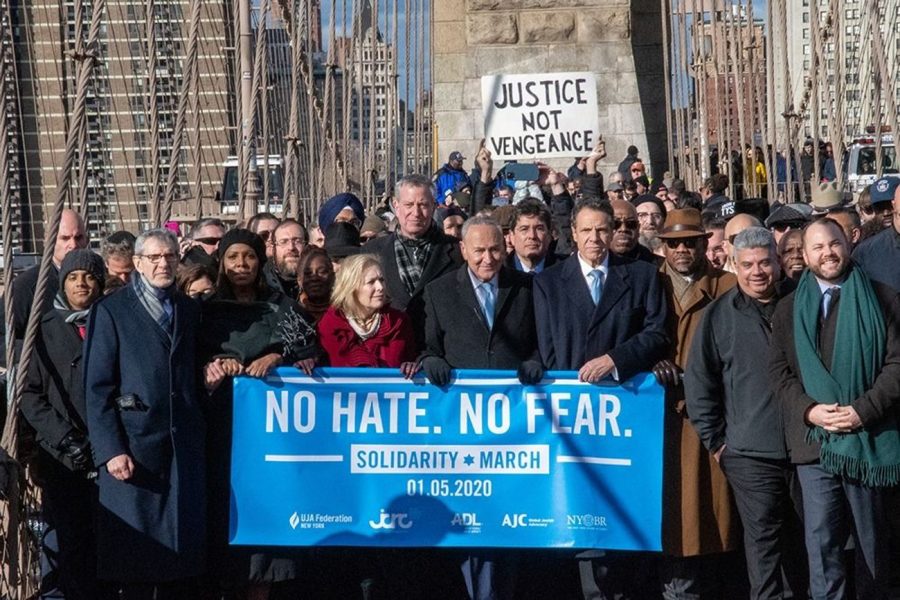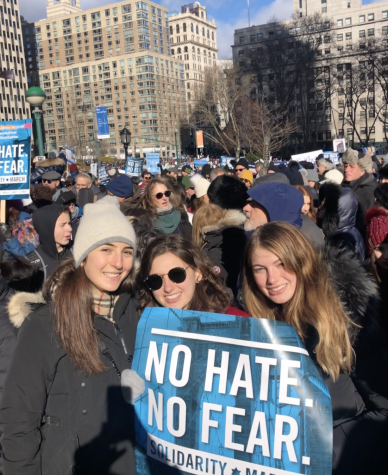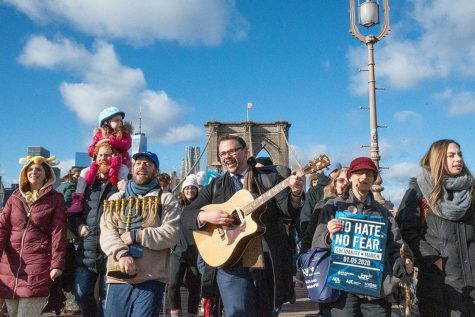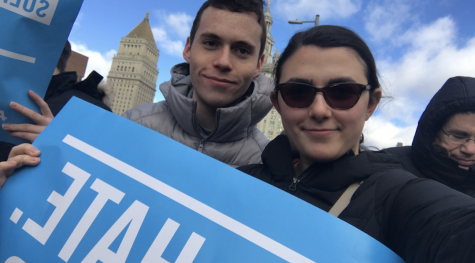
Almost every night of this past Chanukah, as Jews lit the candles, they prayed that the anti-Semitism would be over. However, every night, new headlines appeared: “Five Jews stabbed in Monsey home,” “Jew beat up on NYC street,” “Jew harassed on the subway.” For the past few months, anti-Semitism has been on the rise in the New York/New Jersey area. These attacks shocked the tri-state area and left citizens confused on how to react. It felt like this wave of anti-Semitism would never end. In response, the Jewish community came together to declare that this form of hate will not be tolerated.
On Sunday, January 5, approximately 25,000 people, Jews and non-Jews alike, marched with the UJA Federation in the “No Hate, No Fear Solidarity March.” The rally was sponsored by many different organizations including the Jewish Community Relations Council (JCRC), the ADL, the AJC, the New York Board of Rabbis, and Brooklyn Borough President Eric Adams. With tremendous police supervision, the crowd walked across the Brooklyn Bridge to Foley Square to declare their right to pray in synagogues, celebrate holidays, and wear a kippah on the street without fear.

Additionally, the Ramaz Leadership Team sent out an email to inform parents and students about the event. “For the last week and a half, there have been attacks against Jews in the New York metro area on an almost daily basis. It is time to say enough!” the email read. “We can’t just shake our heads when we read about another attack on Jews; we must take action. We can defeat this, if we stand together.” Although students were repeatedly urged to attend the event as a vital expression of the school’s mission, the plan did not include a central place for students to meet and march as a school. Rabbi Stochel, who was at the march, explained, “We thought of it as a family and community event held on a Sunday and not during the school day. We wanted families with children of all ages to march together, demonstrating the urgency of the march across generations. And it was quite moving to see grandparents, parents and even small children in strollers and baby carriers joining on a cold winter day.”
On the day of the rally, in the freezing weather, thousands arrived. For three hours, Jews marched across the bridge, breaking out in song and dance. One group, The Jewish Federation Against Hate, brought a marching band and dance troupe to express their Jewish pride. Overall, the energy on the bridge was hopeful and motivating.
After crossing the bridge, the crowd gathered in Foley Square to listen to speeches. “Today we are all Pittsburgh, we are all Poway, we are all Hasidim, and we are all Jews, and we are all American,” proclaimed

Anti-Semitism in America affects all Jews, from Charedim in Monsey to Reform Jews in Pittsburgh. Therefore, many Jews and non-Jews from various backgrounds attended the march. Much of the turnout was by non-affiliated, Reform, and Conservative Jews. Diane Reiser, a 74-year-old Reform Jew, explained, “I am a Jew, but I would be here even if I wasn’t because I am also an activist. I have struggled for the last three years with the question: What would I have done if I was a German during the Holocaust? Would I have helped save the Jews? I have come to many demonstrations. I support Muslims and immigrants. I am setting an example for my grandchildren.”
As a result of the Ramaz/KJ community’s endorsement of the march, many Ramaz families arrived with their young children that Sunday morning. Ramaz parent Jennifer Yashar said, “I came with my children to show that we will not stand for anti-Semitism or hate toward any group. The emails and Instagrams motivated me and others to come.” Daniela Niditch, a former teacher at the Ramaz Lower School, explained that there was in fact some debate between parents about whether this event was appropriate for children. She said, “We want our kids to live in a bubble and believe everything is good and safe. But, I brought my daughter and told her that we need to show that we are proud Jews, regardless of who doesn’t like us. Just seeing the magnitude of people who are here is so overwhelming and beautiful, even if she doesn’t really grasp the severity of the event.”

Another issue raised is the question of how to protect against this hate. Niditch said, “Criminals should be jailed and must show up to hearings without being offered rewards. It is no longer a scary thing to commit crimes of anti-Semitism. That is the problem.” On the other side of the spectrum, the Care Not Cops Contingent came to the event, handing out their flyers. Rosza Zushuk, who describes herself as a fourth-generation secular Jew, said, “I am really distressed with the response I have seen coming from large Jewish nonprofit organizations. Police and jails are not the solutions to anti-Semitism. Instead, we need to confront those who are spreading anti-Semitism. This starts with the president. We are seeing that he is spreading anti-Semitism and we need to stop it. This is a slow and complicated process, but it is necessary.”

It is important to note that while this rally was against anti-Semitism, there were non-Jewish activists who came out to support the Jewish community. Fatima Dia, a fourteen-year-old black Muslim girl, said, “I have already experienced hate and discrimination from the time I started to wear my hijab. Today, I am here to show that no form of hate is acceptable.” A large contingent from the Catholic Church of St. Francis Xavier also came to show their support. Cathline Cagnine said, “We are all a family. We will be here and [Jews] can rely on us. We are not here for political reasons, rather to show that we are here for all humanity.”
On January 5, the Brooklyn Bridge overflowed with people. Some were in strollers. Some used canes or wheelchairs. Some wore kippot. Some did not. Some had payis. Some had pink hair. Some wore crosses or hijabs. Some blamed political figures. Some blamed the police. Some sang in Hebrew. Some in English. Some played the drums. But, every person stood in solitary to declare: I will not stand for anti-Semitism.
